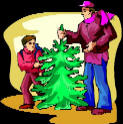
UK Christmas Tree Varieties / Types
Looking for the right tree, but don't know which variety is right for you? This guide will help you decide which Christmas Tree species or types sold and grown in the UK is worth the price and has the properties you want. Click on the links below for more information about each type. The links for photos and more info open new windows, so just close them to return to this page. In general, the Noble Fir, Nordman Fir and Lodge Pole Pine are low needle drop trees and the Norway Spruce (the traditional tree) loses needles more quickly than the others in a hot room.
|
Selection Guide to
the Most Common Christmas Tree Varieties in the UK |
||||||||
| Firs | Pine | Spruces | ||||||
|
Nordmann |
Noble |
Fraser |
Lodgepole |
White |
White |
Norway |
Blue |
|
|
Needle Holding (without water) |
5 | 5 | 5 | 5 | 5 | 3 | 1 | 4 |
|
Needle Holding (with water) |
5 | 5 | 5 | 5 | 5 | 4 | 2 | 5 |
| Firmness Branches | 2 | 3 | 3 | 5 | 2 | 4 | 3 | 5 |
| Fragrance | 5 | 5 | 4 | 3 | 4 | 1 | 3 | 3 |
| Needle softness | 5 | 5 | 5 | 2 | 5 | 3 | 3 | 3 |
| Cost | 2 | 3 | 3 | 5 | 4 | 3 | 2 | 1 |
|
|
||||||||
Firs
- Pines - Spruce - Cedars
- Cypress -
Miscellaneous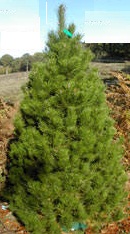
![]()
Firs
Nordmann Fir - An excellent needle retaining species with soft glossy dark green
needles. Nordmann Firs originate from the Caucasus mountains in Georgia,
southern Russia and have seen a steady rise in popularity over recent years.
They are a non needle-drop variety with a darker green coloured foliage and
slightly more rounded needles. An excellent needle retaining species with soft
glossy dark green needles. Nordman Fir is probably the most popular Christmas
tree in this country, one of the reasons being that it has a lovely symmetrical
shape with strong branches. The needles are shiny, mid green and soft to touch. Nordmann Firs are the preferred Christmas tree
on the continent, with long, full, lush, dark green foliage, similar to a Fraser fir,
but softer to the touch and with excellent needle retention. The Nordmann Fir
Christmas Trees can reach 60 feet in height with a spread of 25 to 30 feet.
Their soft and lustrous black-green needles stem from symmetrically arranged
branches, producing the ideal pyramidal specimen for a Christmas tree. Nordmann
Firs are also popular as ornamental trees in parks and gardens. This tree is
very popular in Great Britain.
Wikipedia has more
information.
See the photo at right.
Balsam Fir - Photo - 3/4" to 1 and 1/2" short, flat, long lasting needles that are rounded at the tip; nice, dark green colour with silvery cast and fragrant. These needles are 3/4 - 1 and 1/2 in. in length and last a very long time. This is the traditional American Christmas tree. This tree has a dark-green appearance and retains its pleasing fragrance throughout the Christmas season. Named for the balsam or resin found in blisters on bark. Resin is used to make microscope slides and was sold like chewing gum; used to treat wounds in Civil War.
Canaan Fir -
Photo - Similar to the other eastern firs.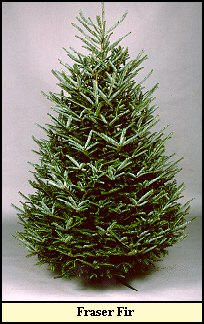
Douglas Fir - Photo - good fragrance; holds blue to dark green; 1" to 1 and 1/2" needles; needles have one of the best aromas among Christmas trees when crushed. The Douglas fir needles radiate in all directions from the branch. When crushed, these needles have a sweet fragrance. They are one of the top major Christmas tree species in the U.S. Named after David Douglas who studied the tree in the 1800's; good conical shape; can live for a thousand years. Close-up photo of tree . Photo credit to The National Christmas Tree Association
Fraser Fir - Photo - dark green, flattened needles; 1/2 to 1 inch long, dark green on the top and silvery underneath; good needle retention; nice scent; pyramid-shaped strong branches which turn upward. The Fraser fir branches turn slightly upward. They have good form and needle-retention. They are dark blue-green in colour. They have a pleasant scent, and excellent shipping characteristics as well. Named for a botanist, John Fraser, who explored the southern Appalachians in the east of the U.S. in the late 1700's.
Photo credit to The National Christmas Tree AssociationGrand Fir - Photo - shiny, dark green needles about 1" - 1 and 1/2" long; the needles when crushed, give off a citrusy smell. Commonly grows only on the west coast.
Korean Fir - This is a variety that is new to the UK. It has silvery underside needles and a fresh pine smell. The appearance is similar to the Norway Spruce and the Nordman, with a distinctive smell. korean Spruce are better at keeping their needles than the Norway Spruce (it still needs to be watered every day) with that special fresh pine smell that fills the room.
Noble Fir - Photo - one inch long, bluish-green needles with a silvery appearance; has short, stiff branches; great for heavier ornaments; keeps well. These needles turn upward, exposing the lower branches. It's extremely aromatic, and while it is native to the West Coast of the U.S., it is popular throughout the U.K. It's shape is similar to a Douglas fir but with a deeper, richer green. Known for its beauty, the noble fir has a long keep ability, and its stiff branches make it a good tree for heavy ornaments, as well as providing excellent greenery for wreaths and garland.
White Fir or Concolour Fir - Photo - blue-green needles are 1/2 to 1/2 inches long; nice shape and good aroma, a citrus scent; good needle retention. They have good foliage colour, good needle retention, and a pleasing shape and aroma. In nature can live to 350 years. Photo credit to The National Christmas Tree Association

Spruce
Norway Spruce - Photo - needles 1/2" - 1" long and shiny, dark green. Needle retention is poor without proper care; strong fragrance; nice conical shape. The Norway Spruce is the traditional Christmas tree which can be found in many homes throughout the UK and Europe. Norway Spruce can be found naturally in Northern and Central Europe. The tree features pointed mid-green colour needles with long cylindrical brown cones which hang down. Many people enjoy its scent once its indoors during December.
Black Hills Spruce - Pinus glauca
var.densata - green to blue-green needles; 1/3" to 1/4" long;
stiff needles may be difficult to handle for small children.
More info.
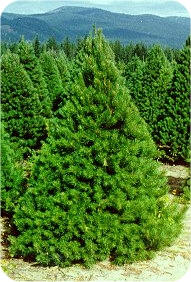
Blue Spruce - Picea pungens - dark green to powdery blue; very stiff needles, 3/4" to 1 and 1/2" long; good form; will drop needles in a warm room; symmetrical; but is best among species for needle retention; branches are stiff and will support many heavy decorations. State tree of Utah & Colourado. Can live in nature 600-800 years. The needles really do have a bluish look to them, as shown in the photo at right. More info.
Colourado Blue Spruce - Photo - Often used for stuffing pine-pillows, these sharp needles are 1 - 1 and 1/2 in. in length. This species is bluish-gray in colour and has a bad odor when needles are crushed. This Christmas Tree has good symmetrical form and has an attractive blue foliage. It also has good needle retention.
 Serbian Spruce - Serbian spruce is native to a small region of limestone
mountains along the upper Drina river of Bosnia and Serbia, in Southeastern
Europe. The upper surface of the needles is glossy, dark green in contrast
to the whitish lower surface.
Serbian Spruce - Serbian spruce is native to a small region of limestone
mountains along the upper Drina river of Bosnia and Serbia, in Southeastern
Europe. The upper surface of the needles is glossy, dark green in contrast
to the whitish lower surface.
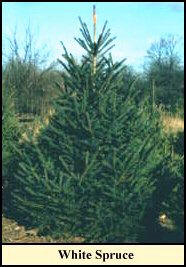 White
Spruce -
Photo - needles 1/2 to 3/4 inch long; green to bluish-green, short,
stiff needles; crushed needles have an unpleasant odor; good needle
retention. State tree of South Dakota. The White Spruce is excellent for
ornaments; it's short, stiff needles are 1/2 - 3/4 in. long and have a blunt
tip. They are bluish-green - green in colour, but have a bad aroma when
needles are crushed. They have excellent foliage colour and have a good,
natural shape. The needle retention is better in a White Spruce than it is
among other spruces. Photo credit to The National Christmas Tree
Association
White
Spruce -
Photo - needles 1/2 to 3/4 inch long; green to bluish-green, short,
stiff needles; crushed needles have an unpleasant odor; good needle
retention. State tree of South Dakota. The White Spruce is excellent for
ornaments; it's short, stiff needles are 1/2 - 3/4 in. long and have a blunt
tip. They are bluish-green - green in colour, but have a bad aroma when
needles are crushed. They have excellent foliage colour and have a good,
natural shape. The needle retention is better in a White Spruce than it is
among other spruces. Photo credit to The National Christmas Tree
Association
Pines
Afghan Pine - soft, short needles with sturdy branches; open appearance; mild fragrance; keeps well; grown in Texas; native to Afghanistan, Russia & Paskistan. More info.
Austrian Pine - dark green needles, 4 to 6 inches long; retains needles well; moderate fragrance. Close-up photo of tree.
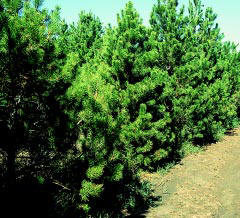 Lodgepole Pine - The Lodge Pole Pine Christmas tree
Lodgepole Pine - The Lodge Pole Pine Christmas tree
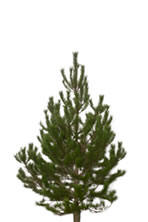 is a native to the Rocky
Mountains, mature trees grow to 30 metres. It was introduced to the UK in
1855 and growers like its resistance to pests and its ability to grow well
on poor wet soils. Typically available from 4ft to 12ft - this a low needle
drop tree. I forms clean, gradually tapering shafts which were used by
Native Americans to make their lodges, hence the name "lodgepole pine." See
the 2 photos at right.
is a native to the Rocky
Mountains, mature trees grow to 30 metres. It was introduced to the UK in
1855 and growers like its resistance to pests and its ability to grow well
on poor wet soils. Typically available from 4ft to 12ft - this a low needle
drop tree. I forms clean, gradually tapering shafts which were used by
Native Americans to make their lodges, hence the name "lodgepole pine." See
the 2 photos at right.
Red Pine - dark green needles 4"-6" long; big and bushy. Close up photo of tree.
Ponderosa Pine - needles lighter coloured than Austrian Pine; good needle retention; needles 5" - 10" long. More info.
Scots Pine -
Photo - most common Christmas tree; stiff branches; stiff, dark green
needles one inch long; holds needles for four weeks; needles will stay on
even when dry; has open appearance and more room for ornaments; keeps aroma
thr oughout the season; introduced into United States by European settlers.
The colour is a bright green. The most common Christmas tree in the U.S., the
Scots Pine has an excellent survival rate, is easy to replant, has great
keepability and will remain fresh throughout the holiday season. See photo
at right and
click here for a close-up photo of tree. Photo credit to
www.christmastree.org/trees/trees/scotch.cfm.
oughout the season; introduced into United States by European settlers.
The colour is a bright green. The most common Christmas tree in the U.S., the
Scots Pine has an excellent survival rate, is easy to replant, has great
keepability and will remain fresh throughout the holiday season. See photo
at right and
click here for a close-up photo of tree. Photo credit to
www.christmastree.org/trees/trees/scotch.cfm.
Virginia Pine - dark green needles are 1 1/2" - 3" long in twisted pairs; strong branches enabling it to hold heavy ornaments; strong aromatic pine scent; a popular southern Christmas tree. These branches are stout and woody and respond very well to trimming. It is small- medium in size and its foliage becomes extremely dense. Aside from being a good nesting site for woodpeckers, the Virginia pine continues to be the most popular Christmas tree in the South. More info.
White Pine - Photo - soft, blue-green needles, 2 to 5 inches long in bundles of five; retains needles throughout the holiday season; very full appearance; little or no fragrance; less allergic reactions as compared to more fragrant trees. The largest pine in the U.S., the White Pine has soft, flexible needles and is bluish-green in colour. Needles are 2 1/2 - 5 in. long. White Pine's have good needle retention, but have little aroma. They are the state tree of Michigan & Maine; slender branches will support fewer and smaller decorations as compared to Scots Pine. They aren't recommended for heavy ornaments. It's wood is used in cabinets, interior finish and carving. Native Americans used the inner bark as food. Early colonists used the inner bark to make cough medicine. Close-up photo of tree.
Cedars
Deodara Cedar - short, bluish-green needles; branches become pendulous at the tips; native to Himalayas; Deodara wood in Asia was used to build temples. In ancient Egypt Dedodara wood was used to make coffins for mummies. Deodara Cedar More info
Eastern Red Cedar - Eastern Red Cedar Photo - leaves are a dark, shiny, green colour; sticky to the touch; good scent; can dry out quickly; may last just 2-3 weeks; a southern Christmas tree.
Cypress
Arizona Cypress - Photo - Native southwestern cypress with soft- textured gray-green foliage.
Leland Cypress - Photo at right - foliage is dark green to gray colour; has upright branches with a feathery appearance; has a light scent; good for people with allergies to other Christmas tree types. The most popular Christmas tree in the South-East, the Leyland Cypress is dark green - gray in colour and has very little aroma. Because it is not in the Pine or Fir family, it does not produce sap, so that those with an allergy to sap can still enjoy a Leyland as their Christmas Tree. More info . (Photo credit to The National Christmas Tree Association)
Carolina Sapphire - Cupressus arizonica var. glabra - 'Carolina Sapphire'- steely, blue needles; dense, lacy foliage; yellow flowers and nice scent; smells like a cross between lemon and mint. More info.